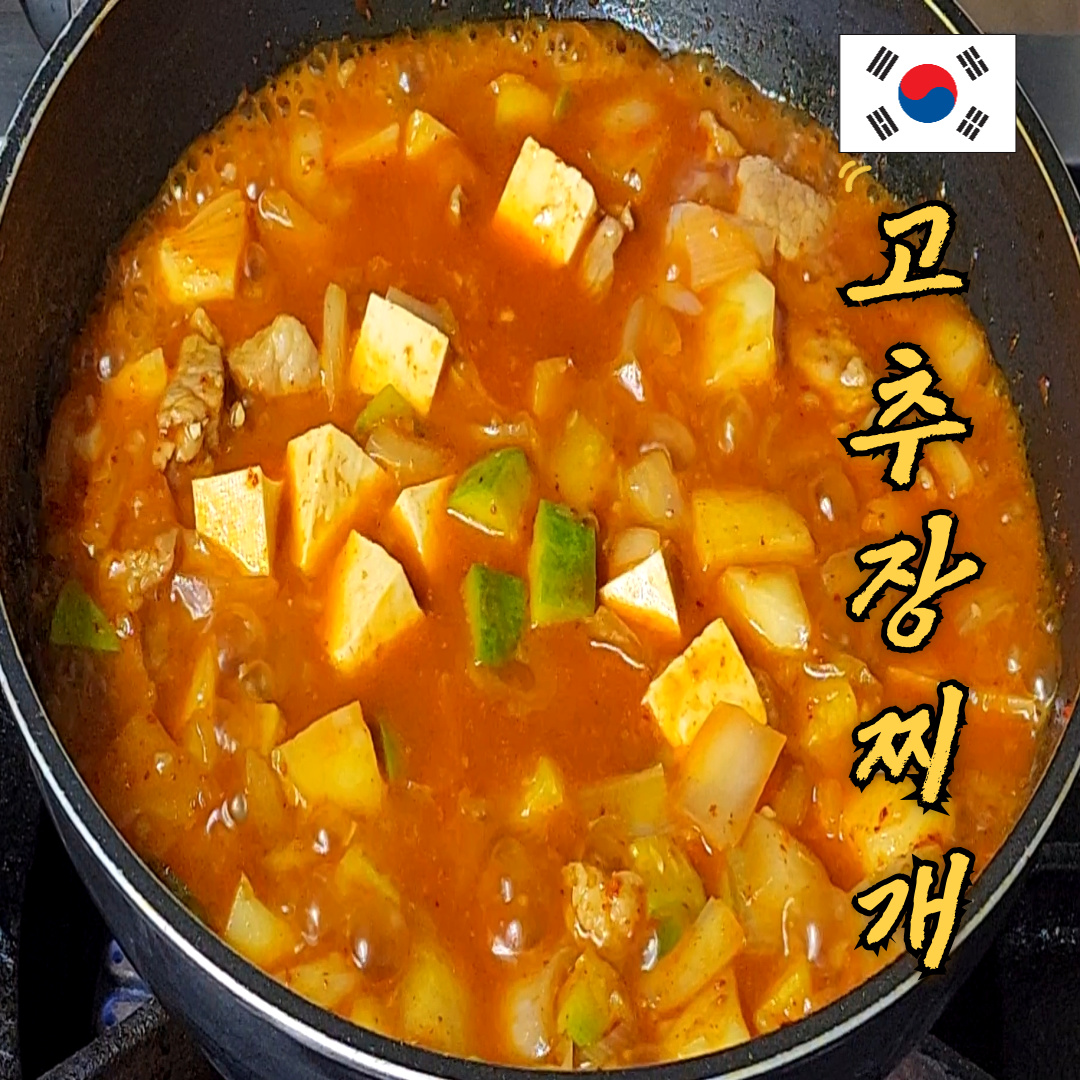Gochujang Stew with Unbeatable Depth of Flavor, Rivaling Jjampong
A Gochujang Stew Recipe That Achieves a Deep, Umami-Rich Flavor, Surpassing Jjampong, Thanks to a Unique Stir-Frying Method

This Gochujang stew recipe employs a slightly different stir-frying technique than usual. As you stir-fry, a subtle aroma reminiscent of Jjampong (spicy seafood noodle soup) emerges, and the finished stew boasts a rich, umami-packed flavor that will make even Jjampong jealous! Simmer it down to a rich consistency and enjoy a truly delicious meal. 🙂 Feel free to ask any questions in the comments section as you cook!
Main Ingredients- 200g Pork for Stew (sliced)
- 1/2 Korean Zucchini (Aehobak)
- 1 Potato
- 1/3 stalk Green Onion (white part preferred)
- 1/2 Onion
- 3 cloves Garlic (large)
- 1 Korean Chili Pepper (Cheongyang Pepper)
- 1/2 block Firm Tofu (optional)
Seasonings and Condiments- 2 Tbsp Soy Sauce (30ml)
- 2 Tbsp Sugar (30g)
- 1 tsp Fish Sauce (e.g., Anchovy or Sand Lance, 5ml)
- 1 tsp Salt (5g)
- 1 Tbsp Soju or Rice Wine (15ml)
- 1 Tbsp Gochugaru (Korean chili flakes, for stir-frying)
- 2 Tbsp Gochujang (Korean chili paste, for stewing)
- 2 Tbsp Soy Sauce (30ml)
- 2 Tbsp Sugar (30g)
- 1 tsp Fish Sauce (e.g., Anchovy or Sand Lance, 5ml)
- 1 tsp Salt (5g)
- 1 Tbsp Soju or Rice Wine (15ml)
- 1 Tbsp Gochugaru (Korean chili flakes, for stir-frying)
- 2 Tbsp Gochujang (Korean chili paste, for stewing)
Cooking Instructions
Step 1
Marinate the 200g of pork for stew with 1 Tbsp of soju (or rice wine) and 1 tsp of salt. Mix well. This step tenderizes the pork and removes any gamey odor.

Step 2
Slice the zucchini into 0.5cm thick half-moons and thinly slice the onion. Cutting vegetables to similar sizes ensures they cook evenly.

Step 3
Finely mince the 3 large cloves of garlic. You can press them flat with the side of your knife and then chop, or use a garlic press. Minced garlic from a jar also works.

Step 4
Slice the green onion diagonally, focusing on the white part, about 0.5cm thick. This adds a fragrant aroma to the stew.

Step 5
Peel the potato and cut it into bite-sized cubes, similar in size to the zucchini. If using tofu, cut it into similar sized cubes as well.

Step 6
Remove the stem from the Korean chili pepper and slice it thinly on the diagonal. If you like it spicier, you can add up to two peppers.

Step 7
In a pot or deep pan, add 2 Tbsp of sugar over medium-low heat and slowly melt it until it caramelizes to a light brown color. Be careful not to burn it. This caramelization adds a deep color and complex flavor to the stew.

Step 8
Add the marinated pork to the caramelized sugar and stir-fry over high heat until the surface of the pork is browned. This allows the pork to absorb the caramel’s richness and color.

Step 9
Once the pork is browned, add 1 Tbsp of gochugaru (chili flakes) and stir-fry briefly. Then, drizzle about a tablespoon of cooking oil around the edges of the pan and continue to stir-fry with the pork. This prevents the chili flakes from burning and enhances their flavor.

Step 10
Add the minced garlic and diagonally sliced green onions, and stir-fry until fragrant. The pungent garlic and fresh green onion aroma will meld beautifully with the pork.

Step 11
Finally, add the sliced onions and stir-fry until they become translucent. The sweetness from the onions will dissolve into the stew, adding to its overall umami.

Step 12
Allow the stir-fried ingredients to slightly stick to the bottom of the pan for a moment. This ‘fond’ or caramelized bits further enhance the stew’s natural flavors and aromas. (A little sticking is a good tip!)

Step 13
Pour in 1 liter of water and bring to a rolling boil over high heat. Using anchovy-kelp broth instead of water will yield an even richer flavor.

Step 14
As the stew begins to boil, reduce the heat to medium-low and skim off any foam that rises to the surface with a spoon. This results in a clearer broth and a cleaner taste.

Step 15
Add the cubed potatoes and zucchini. Let them cook until the potatoes are starting to soften.

Step 16
Stir in 2 Tbsp of gochujang (chili paste) and 1 tsp of fish sauce. If you desire an extra boost of umami, you can add 1 tsp of MSG (optional). Since we’ve already added sugar and soy sauce, the fish sauce is primarily for adjusting saltiness and adding depth.

Step 17
Adjust the color of the stew by adding more gochugaru if needed. Gently add the cubed tofu and simmer for a little longer. Stir carefully to avoid breaking the tofu.

Step 18
The stew is ready when the potatoes are fully cooked and the broth has thickened slightly to a rich, not watery, consistency. A slightly thicker broth is perfect for mixing with rice.

Step 19
Enjoy a special Gochujang stew made with uniquely stir-fried pork, boasting a flavor depth that truly rivals Jjampong! Make your weekend dinner truly special with this recipe. 🙂



